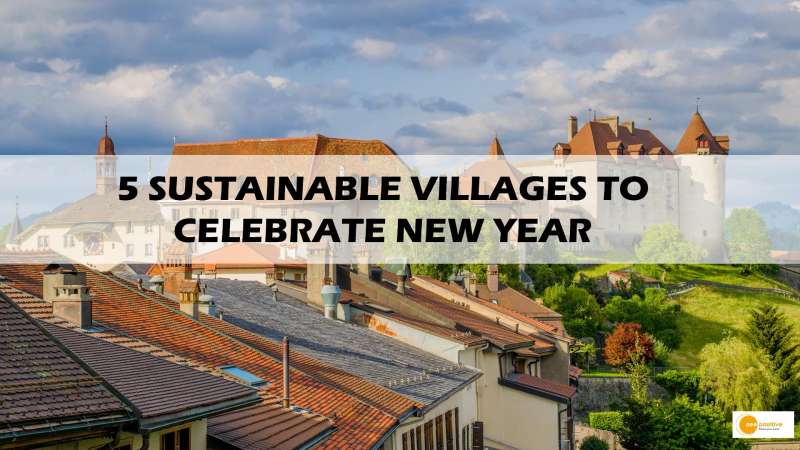

The United Nations World Tourism Organization (UNWTO) recognises villages that are an outstanding example of a rural tourism destination with recognised cultural and natural assets, that preserve and promote rural and community-based values, products, and lifestyles, and that have a clear commitment to innovation and sustainability in all aspects – economic, social, and environmental. In 2021, they chose 44 villages from 32 countries spread across five regions for the same purpose.
From that list, we have selected the top five sustainable villages in which to spend New Year’s Eve. Tourism destinations that help to preserve cultures and traditions, celebrate diversity, provide opportunities, and protect biodiversity.
1. KAUNERTAL, AUSTRIA – The famous “Gepatschferner” glacier, one of the highest and most spectacular glaciers in Tyrol, is located in KAUNERTAL, AUSTRIA. It is also a part of a nature park established on the initiative of the local community. Since 2021, it has included 40% of the region’s total natural area. Prior to the development of tourism, the valley was known for its small-scale agriculture. Kaunertal faced the challenges of sustainable tourism with the project “CLEAN ALPINE REGION,” with a special focus on climate change adaptation and environmental protection. The valley’s efforts include special projects to replace fossil fuels in heating and transportation. The initiative’s main goal is to create value in terms of employee well-being, regional products, and climate-friendly management.
2. SOUFLI, GREECE – it is a settlement in the Evros region that is distinguished by a well-known tourist dipole, the National Park of Dadia-Soufli-Levkimi. The silk tradition, which includes vigorous traditional economic activities ranging from mulberry tree cultivation to silk production and promotion, as well as the historical architecture of its “cocoon-houses,” has been preserved. Soufli retains its authenticity and is not distorted by uncontrolled development. As a result, the possibility of developing a viable tourism proposal is strongly justified. The development and promotion of a distinct culture and an appealing local identity respond to the required characteristics, standards, and market demands, such as accessibility, clarity, relaxation, connection with the local ambience, marketable, tangible, and intangible products, and so on.
3. SWITZERLAND, GRUYRES – Local products are an important part of the Gruyères identity. Agriculture is deeply ingrained in the village’s identity and will always be at the heart of tourism development, particularly in relation to the production of the “Gruyère AOP Switzerland” cheese. The “La Maison du Gruyère” demonstration cheese dairy showcases the world-famous Gruyère AOP. Visitors are welcome to observe the cheese-making process in real time. Traditional restaurants serve the legendary “moitié-moitié” cheese fondue of La Gruyère.
The village is also an example of how a four-season mountain destination can be sustainable. Gruyères was recognised for its high commitment in the nine areas of evaluation of the Best Tourism Village initiative, including its advancement in the conservation of natural and cultural resources (Gruyères joined the Regional Nature Park Gruyère pays d’Enhaut officially in 2021), the commitment of its DMO, which helps farmers develop tourism products such as cheese dairy visits and accommodation offer, and for being a remarkable example in the use of intelligence.
4. Malaysia – Batu Puteh – The Batu Puteh community was at a crossroads in 1996. After over 40 years of extracting huge logs from the rainforest by large companies using large machinery, the community of Batu Puteh was left in the middle of a vast agricultural landscape, with no logs and no jobs.
Fortunately, the government established a small protected Forest Reserve around the village, and in 1996, a group of visionary youths from the Batu Puteh Community decided to try to earn a living from tourism, to preserve their traditional culture, and to help protect the remaining forest ecosystem, all while creating jobs and long-term income.
After three years of research, training, and planning, the Batu Puteh core youth group had developed five key products and established four separate tourism associations throughout the village, including the Miso Walai Homestay, the Maya do Talud Boat Service, the Wayan Forest Guide Service, and the Monompos Culture Group. It was the year 2000. After three years of operation and small-scale ecotourism activities, the village tourism associations banded together in 2003 to form the Community Cooperative (co-op) KOPEL Bhd.
5. Le Morne – MAURITIUS – Séga music’s cradle – Aside from its charming inhabitants, the village of Le Morne is known for its exceptional natural and cultural resources. Indeed, the fact that this historical, colourful, and peaceful village is surrounded by the ocean and the mountain is one of its distinguishing features.
The majestic mountain of Le Morne Brabant, located on the peninsula that juts into the Indian Ocean in the southwest of Mauritius, has gained international recognition as a UNESCO World Heritage Site as “Le Morne Cultural Landscape” due to its outstanding universal value and exceptional testimony to “maroonage,” as well as as a symbol of slaves’ fight for freedom.
Several shades of blue can be found in the lagoon of le Morne, which, in addition to providing a source of income for fishermen, is also home to a variety of nautical activities. The waters surrounding the peninsula are widely regarded as one of the best kite-surfing locations in the world. The famous underwater waterfall, which is a spectacular optical illusion, is another of its hidden treasures and unique to the waters of Le Morne.
Aside from those one-of-a-kind natural wonders, culture, heritage, history, and emotions give this fishermen village a distinct vibe that can be found nowhere else. Local culture contributes to the identity and sense of belonging of the multi-ethnic local inhabitants, which is passed down from generation to generation through traditional cuisines, myths and legends, and music. The “Séga” music, which is said to have originated in Le Morne, is listed as UNESCO World Heritage intangible.


